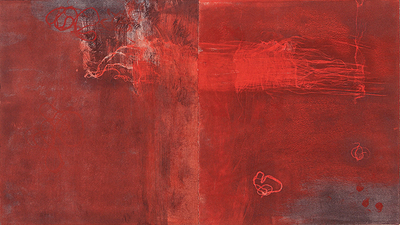Susan Osgood: Mapping the Unknown

Susan Osgood, Red Sea 5, 2009, diptych, monotype print, 13 x 23 1/4 “.
In addition to being an artist, for the past 30 years Susan Osgood has been an archaeological illustrator in Egypt. While working in Luxor, the site of ancient Thebes, she discovered a 12th-century map whose geography didn’t make sense…the north was on the bottom. Unable to read it as a map, she saw it as abstract elements and was enthralled by its snaking lines, “delicate, curving, changing course, dancing,” as she described it. This artifact opened her to the concept of “mapping”—and, she says, reintroduced her to line.
Osgood lives and works in Brattleboro, VT, yet her inspiration comes from the desert and the waters of her Egyptian sojourns. This show of 30 paintings, prints and drawings, from 2013 to the present, is all about the resonance of line. Her monotype diptychs, from a series titled Red Sea, incorporate gauze that unravels and disintegrates, adding intriguing texture. The colors seems to burn with an inner fire, the textures and marks consumed into it yet alive and scintillating. The oils are luminous color-fields of oranges, purples and yellows, with floating glyph-like forms that seem to hover—appearing and disappearing—into the ground of color.
Osgood felt an “urgency” to someday create a map of water, “a diagram of its very essence.” She was inspired by “the natural systems in water—such as its microbial life—[that] make up a staggering 90 percent of the ocean’s total biomass, yet still remain a mystery to science,” according to her artist’s statement in her recent book, The Ghosts of Water. These “diagrams” are in varying tones of blue, from deepest cyan to almost white. Dancing above the richly textured base, in some cases subsumed into it, her linear elements are bold and thick, or subtle, like the barely discernible remains of an ancient text.
Embedded in Map of Water 2—the largest print in the series—is a life-sized drawing of a woman. The tragic story of a loss lies behind this piece. As in all of her work, Osgood has transformed the story into something numinous and the figure is both mythic and noble.
